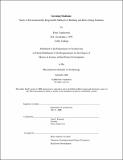Greening stadiums : study of environmentally responsible methods of building and retro-fitting stadiums
Author(s)
Vanderweil, Peter
DownloadFull printable version (695.5Kb)
Other Contributors
Massachusetts Institute of Technology. Center for Real Estate.
Advisor
John F. Kennedy.
Terms of use
Metadata
Show full item recordAbstract
Sustainable development for stadiums and arenas is a recent topic gaining interest throughout professional sports ownership groups worldwide. Stadiums have lagged behind in understanding the best practices surrounding the analysis and implementation of green building techniques due to their unique nature, while other more conventional building types have developed and implemented a standard system of practices with regards to sustainable design. Abnormal usage patterns, variable climate conditions, and slow changing operational structures with longstanding policies are all hurdles facing organizations as they attempt to make their stadiums greener. This thesis investigates and lists current examples of green friendly design and operations that exist in stadiums worldwide. It then considers an analysis of the LEED certification process, supply chain management, transportation infrastructure, recycling programs, and innovative design measures. The thesis also investigates the organizational and technical hurdles that many teams face in implementing these green features despite apparent widespread demand to adopt them. Many facets of greening stadiums have been implemented throughout the world, mostly using the existing framework that has been designed towards conventional buildings during recent years. Teams that have had the greatest success have shown a willingness to learn and understand the greening options available to them. This includes how these options fit into the physical confines of the stadium, its surrounding environment, and the overall business and social objectives of the organization. Successful adopters also strive to adapt their existing organizational and operational framework to position themselves to benefit from new techniques that could further enhance their stadium's overall green characteristics. (cont.) Greening the current and future stadiums of the world is a continuous process. Teams that begin to implement sustainable practices generally find the process infectious, where more ideas and programs are soon born from previous initiatives. Organizational and technical leadership are keys to driving innovation and change.
Description
Thesis (S.M. in Real Estate Development)--Massachusetts Institute of Technology, Dept. of Architecture, Center for Real Estate, 2008. This electronic version was submitted by the student author. The certified thesis is available in the Institute Archives and Special Collections. Includes bibliographical references (leaves 44-47).
Date issued
2008Department
Massachusetts Institute of Technology. Center for Real Estate; Massachusetts Institute of Technology. Department of ArchitecturePublisher
Massachusetts Institute of Technology
Keywords
Architecture., Center for Real Estate.